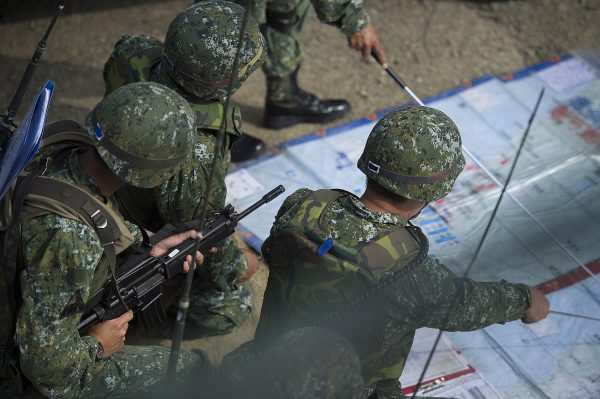In a recent piece in The Hill, defense and naval power expert, and former undersecretary of the Navy, Seth Cropsey describes “three steps” the U.S. can take now to win, or at least deter, a Pacific war with China over Taiwan.
A senior fellow at the Hudson Institute and director of its Center for American Seapower, in addition to serving as deputy Undersecretary of the Navy in the Reagan and George H. W. Bush administrations, Cropsey was also principal Assistant Secretary of Defense for Special Operations/Low Intensity Conflict. Prior to all that he served as a US naval officer.
And those are just career highlights. Few understand naval power like Cropsey.
In his latest piece – after describing the geopolitical realities facing China and the U.S. in today’s COVID world, and the recent escalating tensions in the South China Sea (SCS) and Taiwan Straits – Cropsey delves into how the current climate could rapidly escalate into a conflict.
Once it does, quickly capturing Taiwan and severely damaging and dislocating U.S. forces would be the primary objectives of the Chinese regime. Avoiding a protracted war is key to any Chinese war strategy. As Cropsey notes:
If a war broadened to include the U.S. and Japan, China likely would seek to terminate the conflict as rapidly as possible. A long war carries severe risks for Chinese society; as the natural patriotism of conflict dilutes, the system will be hard-pressed to justify the extreme economic and physical costs of great-power war. By striking the key nodes in America’s military network — the historically protected aircraft carriers and superbases that undergird American power — China hopes to disrupt and damage the U.S. enough to consolidate its gains and to stress an American economy unprepared for swift and massive defense production.
As part of their blitzkrieg assault plan, “Gaining air superiority over Taiwan is clearly central to any Chinese strategy, explains Cropsey. “The American and allied response must be to prevent this or, at a minimum, raise the costs of gaining superiority to a high enough level that China must commit its reserves.”
To achieve this, the U.S. can take three immediate steps to deny China the quick victory it needs. First, says Cropsey, “it can forward-deploy air defenses in the Ryukyu Islands in concert with Japan. Less important than aircraft are anti-air missile systems and early-warning radars that allow the U.S. to shuffle forces as rapidly as possible.”
As I have written about, China has recently been encroaching on nearby “contested” Senkaku Islands with its paramilitary “fishing fleet” in an attempt to gradually establish a measure of control over them. Japan must vigorously resist, and adding air defenses to Ryukyu Islands would also help Japan buttress their own control in the area.
Second, the U.S., in concert with its allies, must develop survivable ground-based air defenses — mobile enough to be concentrated where necessary while avoiding enemy detection or surviving multiple hits. Moreover, the system must be cheap enough to be fielded in large numbers, perhaps by distributing and networking radar nodes across an area of operations.
Third, adds Cropsey, U.S. Indo-Pacific Command needs to better understand Taiwanese contingency planning. Until it receives its recent massive order of 66 advanced F-16Vs jet fighters from the U.S., “Taiwan has a limited modern fighter fleet of F-16s; it relies on much older F-5s for outer-island air defense, particularly to the south. China understands this.”
China’s recent cross-strait provocations and carrier operations this summer were likely intended not only to intimidate but to test Taiwanese fighter and interceptor deployments. The U.S. must fully “understand these Taiwanese deployments both to cover Taiwan’s defensive gaps and to identify the most likely points at which Chinese fleet groups will concentrate to create an operational breakthrough on either side of the island.”
Bottom line, to prevent or win a war against China over Taiwan, the U.S. must fully understand the operational realities of Chinese military planning for an invasion, as well as Taiwanese planning for its defense, and start responding immediately.
Only by providing realistic counters to China’s capabilities today, can the U.S. successfully deter the Chinese regime, or if needed, defeat it in a real war in the Pacific. Cropsey’s proposed three steps are solid recommendations to help achieve that.
Advertisement
Send the Next GOP SUPERSTAR Kim Klacik to Congress [ACT NOW]
















Mine the East China Sea west of Taiwan to start with.
Does the pentagon have a “good idea” box?